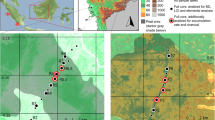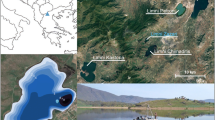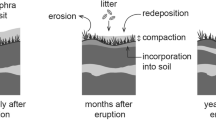Abstract
Vegetation plays a key role in preventing the remobilisation of tephra and aeolian activity following tephra fall. Recent volcanic eruptions in Iceland have highlighted the consequences of tephra fall for ecosystems and human health. Improved understanding of the mechanisms behind ecosystem recovery following tephra fall is particularly important for Iceland. Today ~42% of the country is classified as desert and unvegetated and sparsely vegetated areas are unable to trap tephra fall and prevent subsequent wind erosion. This paper presents palaeoenvironmental reconstructions before and after the Hekla 4 tephra from two lakes in Northwest Iceland, from within a woodland in the lowland, and in open woodland under stress at the highland margin. The c. 4,200 cal bp. Hekla 4 tephra is one of the most extensive Icelandic Holocene tephra layers and the eruption produced an estimated ~9 km3 of tephra. The palaeoecological reconstructions provide an insight into the responses of two relatively stable ecosystems to thick tephra deposits during a period of cooling climate. The understory vegetation in the lowland woodland was buried by the tephra, however Betula pubescens trees were not severely affected and the woodland recovered relatively quickly. In contrast, open woodland at the highland margin that was already at its ecological limit, shifted to dwarf shrub heath, a more resilient vegetation community in response to the tephra fall and cooling climate.

(adapted from Larsen and Thorarinsson 1977). Stars denote study sites Kagaðarhóll (K) and Barðalækjartjörn (B); b soil profile from a wetland close to Kagaðarhóll, including tephra layers Hekla 4 and Hekla 3; c the Hekla 4 tephra layer in a soil core from a wetland close to Barðalækjartjörn. The thickness of the Hekla 4 tephra is indicated








Similar content being viewed by others
Explore related subjects
Discover the latest articles and news from researchers in related subjects, suggested using machine learning.References
Antos JA, Zobel DB (2005) Plant responses in forests of the tephra-fall zone. In: Dale VH, Swanson FJ, Crisafulli CM (eds) Ecological responses to the 1980 eruption of Mount St. Helens. Springer, New York, pp 47–58
Arnalds O (2013) The influence of volcanic tephra (ash) on ecosystems. In: Sparks D (ed) Advances in Agronomy, vol 121. Elsevier, Amsterdam, pp 332–380
Arnalds O (2015) The soils of Iceland. Springer, Dordrecht
Arnalds O, Thorarinsdottir EF, Thorsson J, Waldhauserova PD, Agustsdottir AM (2013) An extreme wind erosion event of the fresh Eyjafjallajokull 2010 volcanic ash. Sci Rep 3:1257
Arnalds O, Dagsson-Waldhauserova P, Olafsson H (2016) The Icelandic volcanic aeolian environment: Processes and impacts—a review. Aeolian Res 20:176–195
Bengtsson L, Enell M (1986) Chemical analysis. In: Berglund BE (ed) Handbook of Holocene Palaeoecology and Palaeohydrology. Wiley, Chichester, pp 423–451
Bennett KD (2016) Catalogue of pollen types. Queen’s University of Belfast. http://www.chrono.qub.ac.uk/pollen/pc-intro.html. Accessed 30 April 2016
Berggren G (1969) Atlas of seeds and small fruits of Northwestern-European plant species (Sweden, Norway, Denmark, East Fennoscandia and Iceland) with morphological descriptions. Part 2: Cyperaceae. Swedish Natural Science Research Council, Stockholm
Birks HJB (1973) Modern pollen studies in some arctic and alpine environments. In: Birks HJB, West RG (eds) Quaternary Plant Ecology. Blackwell, Oxford, pp 143–168
Birks HH (2007) Plant Macrofossils—introduction. In: Elias SA (ed) Encyclopedia of Quaternary Science, 2nd edn. Elsevier, Amsterdam, pp 2,266–2,288
Birks HH, Bjune AE (2010) Can we detect a west Norwegian tree line from modern samples of plant remains and pollen? Results from the DOORMAT project. Veget Hist Archaeobot 19:325–340
Björck S, Persson T, Kristersson I (1978) Comparison of two concentration methods for pollen in minerogenic sediments. GFF 100:107–111
Blaauw M (2010) Methods and code for ‘classical’ age-modelling of radiocarbon sequences. Quat Geochronol 5:512–518
Blair CL, Geirsdottir A, Miller GH (2015) A high-resolution multi-proxy lake record of Holocene environmental change in southern Iceland. J Quat Sci 30:281–292
Brady NC, Weil RR (1996) Elements of the nature and properties of soils, 2nd edn. Pearson Prentice-Hall, Upper Saddle River
Buckland P, Gerrard A, Larsen G, Perry D, Savory D, Sveinbjarnardóttir G (1986) Late Holocene palaeoecology at Ketilsstadir in Mýrdalur, South Iceland. Jökull 36:41–55
Cappers RTJ, Bekker RM, Jans JEA (2012) Digitale Zadenatlas van Nederland, 2nd edn. Barkhuis & Groningen University Library, Groningen
Carey RJ, Houghton BF, Thordarson T (2010) Tephra dispersal and eruption dynamics of wet and dry phases of the 1875 eruption of Askja Volcano, Iceland. Bull Volcanol 72:259–278
Carlsen HK, Gislason T, Benediktsdottir B, Kolbeinsson TB, Hauksdottir A, Thorsteinsson T, Briem H (2012a) A survey of early health effects of the Eyjafjallajökull 2010 eruption in Iceland: a population-based study. BMJ Open 2:e000343
Carlsen HK et al. (2012b) Health effects following the Eyjafjallajökull volcanic eruption: a cohort study. BMJ Open 2:e001851
Caseldine C, Langdon P, Holmes N (2006) Early Holocene climate variability and the timing and extent of the Holocene thermal maximum (HTM) in northern Iceland. Quat Sci Rev 25:2,314–2,331
Cutler NA, Bailey RM, Hickson KT, Streeter RT, Dugmore AJ (2016) Vegetation structure influences the retention of airfall tephra in a sub-Arctic landscape. Prog Phys Geogr 40:661–675
Dearing J (1994) Environmental magnetic susceptibility Using the Bartington MS2 system. Chi Publishing, Kenilworth
Dugmore AJ, Cook GT, Shore JS, Newton AJ, Edwards KJ, Larsen G (1995) Radiocarbon dating tephra layers in Britain and Iceland. Radiocarbon 37:379–388
Dugmore AJ et al (2005) The Norse landnám on the North Atlantic islands: an environmental impact assessment. Polar Rec 41:21–37
Dugmore AJ, Church MJ, Mairs K-A, McGovern TH, Perdikaris S, Vésteinsson O (2007) Abandoned farms, volcanic impacts, and woodland management: revisiting Þjórsárdalur, the “Pompeii of Iceland”. Arctic Anthropol 44:1–11
Dugmore AJ, Gísladóttir G, Simpson IA, Newton A (2009) Conceptual models of 1200 years of Icelandic soil erosion reconstructed using tephrochronology. Journal of the North Atlantic 2:1–18
Eddudóttir SD, Erlendsson E, Gísladóttir G (2015) Life on the periphery is tough: Vegetation in Northwest Iceland and its responses to early-Holocene warmth and later climate fluctuations. Holocene 25:1,437–1,453
Eddudóttir SD, Erlendsson E, Tinganelli L, Gísladóttir G (2016) Climate change and human impact in a sensitive ecosystem: the Holocene environment of the Northwest Icelandic highland margin. Boreas 45:715–728
Edwards K, Craigie R (1998) Palynological and vegetational changes associated with the deposition of Saksunarvatn ash in the Faroe Islands. Fróðskaparrit 46:245–258
Edwards KJ, Dugmore AJ, Blackford JJ (2004) Vegetational response to tephra deposition and land-use change in Iceland: a modern analogue and multiple working hypothesis approach to tephropalynology. Polar Rec 40:113–120
Einarsson P (2008) Plate boundaries, rifts and transforms in Iceland. Jökull 58:35–58
Erlendsson E (2007) Environmental change around the time of the Norse settlement of Iceland. PhD Thesis, University of Aberdeen
Erlendsson E, Edwards KJ, Buckland PC (2009) Vegetational response to human colonisation of the coastal and volcanic environments of Ketilsstaðir, southern Iceland. Quat Res 72:174–187
Fægri K, Iversen J (1989) In: Fægri K, Kaland PE, Krzywinski K (eds) Textbook of Pollen Analysis. 4th edn. Wiley, Chichester
Gathorne-Hardy FJ, Erlendsson E, Langdon PG, Edwards KJ (2009) Lake sediment evidence for late Holocene climate change and landscape erosion in western Iceland. J Paleolimnol 42:413–426
Geirsdóttir Á, Miller GH, Larsen DJ, Ólafsdóttir S (2013) Abrupt Holocene climate transitions in the northern North Atlantic region recorded by synchronized lacustrine records in Iceland. Quat Sci Rev 70:48–62
Gísladóttir G, Erlendsson E, Lal R (2011) Soil evidence for historical human-induced land degradation in West Iceland. Appl Geochem 26:S28–S31
Gísladóttir FÓ, Brink SH, Arnalds Ó (2014) Nytjaland (Icelandic Farmland Database). Agricultural University of Iceland Report 49 [In Icelandic, English summary]
Grimm EC (2011) TILIA 1.7.16. Illinois State Museum, Springfield
Gudmundsson MT et al. (2012) Ash generation and distribution from the April-May 2010 eruption of Eyjafjallajökull, Iceland. Sci Rep 2:572
Hallsdóttir M (1987) Pollen analytical studies of human influence on vegetation in relation to the landnám tephra layer in southwest Iceland. PhD Thesis, Lund University
Hallsdóttir M (1995) On the pre-settlement history of Icelandic vegetation. Búvísindi 9:19–29
Hallsdóttir M, Caseldine CJ (2005) The Holocene vegetation history of Iceland, state-of-the-art and future research. In: Caseldine C, Russel A, Harðardóttir J, Knudsen Ó (eds) Iceland—modern processes and past environments. Elsevier, Amsterdam, pp 319–334
Hicks S (2001) The use of annual arboreal pollen deposition values for delimiting tree-lines in the landscape and exploring models of pollen dispersal. Rev Palaeobot Palynol 117:1–29
Horwell CJ, Baxter PJ (2006) The respiratory health hazards of volcanic ash: a review for volcanic risk mitigation. Bull Volcanol 69:1–24
Horwell C, Baxter P, Kamanyire R (2015) Health impacts of volcanic eruptions. In: Loughlin SC, Sparks S, Brown SK, Jenkins SF, Vye-Brown C (eds) Global Volcanic Hazards and Risk. Cambridge University Press, Cambridge, pp 289–294
Karlsdóttir L, Hallsdóttir M, Thórsson AT, Anamthawat-Jónsson K (2008) Characteristics of pollen from natural triploid Betula hybrids. Grana 47:52–59
Karlsdóttir L, Hallsdóttir M, Thórsson ÆT, Anamthawat-Jónsson K (2009) Evidence of hybridisation between Betula pubescens and B. nana in Iceland during the early Holocene. Rev Palaeobot Palynol 156(3–4):350–357
Karlsdóttir L, Hallsdóttir M, Thórsson ÆT, Anamthawat-Jónsson K (2012) Early Holocene hybridisation between Betula pubescens and B. nana in relation to birch vegetation in Southwest Iceland. Rev Palaeobot Palynol 181:1–10
Katz NJ, Katz SV, Kipiani MG (1965) Atlas and keys of fruits and seeds occuring in the Quaternary deposits of the USSR. Publishing House Nauka, Moscow
Kristinsson H (2010) Flowering plants and ferns of Iceland. Mál og menning, Reykjavík
Kuoppamaa M, Huusko A, Hicks S (2009) Pinus and Betula pollen accumulation rates from the northern boreal forest as a record of interannual variation in July temperature. J Quat Sci 24:513–521
Larsen G, Thorarinsson S (1977) H4 and other acid Hekla tephra layers. Jökull 27:28–46
Larsen DJ, Miller GH, Geirsdóttir Á, Ólafsdóttir S (2012) Non-linear Holocene climate evolution in the North Atlantic: a high-resolution, multi-proxy record of glacier activity and environmental change from Hvítárvatn, central Iceland. Quat Sci Rev 39:14–25
Larsen G, Gudmundsson MT, Vogfjörð K, Ilyinskaya E, Oddsson B, Pagneux E (2015a) The Bárðarbunga volcanic system. In: Ilyinskaya E, Larsen G, Gudmundsson M (eds) Catalogue of Icelandic Volcanoes. IMO, UI, CPD–NCIP
Larsen G, Gudmundsson MT, Vogfjörð K, Ilyinskaya E, Oddsson B, Pagneux E (2015b) The Katla volcanic system. In: Ilyinskaya E, Larsen G, Gudmundsson M (eds) Catalogue of Icelandic Volcanoes. IMO, UI, CPD–NCIP
Larsen G, Thordarson T, Vogfjörð K, Ilyinskaya E, Oddsson B, Pagneux E (2015c) The Hekla volcanic system. In: Ilyinskaya E, Larsen G, Gudmundsson M (eds) Catalogue of Icelandic Volcanoes. IMO, UI, CPD–NCIP
Liu E, Cashman K, Beckett F, Witham C, Leadbetter S, Hort M, Guðmundsson S (2014) Ash mists and brown snow: remobilization of volcanic ash from recent Icelandic eruptions. J Geophys Res, Atmospheres 119:9,463–9,480
Mack RN (1987) Effects of Mount St Helens ashfall in steppe communities of eastern Washington: one year later. In: Bilderback DE (ed) Mount St Helens 1980—Botanical Consequences of the Explosive Eruptions. University of California Press, Berkeley, pp 262–281
Mäkelä EM (1996) Size distinctions between Betula pollen types—a review. Grana 35:248–256
McGovern TH et al. (2007) Landscapes of settlement in northern Iceland: Historical ecology of human impact and climate fluctuation on the millennial scale. Am Anthropol 109:27–51
Moore PD, Webb JA, Collison ME (1991) Pollen analysis. Blackwell Scientific Publications, Oxford
Nakagawa T, Brugiapaglia E, Digerfeldt G, Reille M, Beaulieu J-LD, Yasuda Y (1998) Dense-media separation as a more efficient pollen extraction method for use with organic sediment/deposit samples: comparison with the conventional method. Boreas 27:15–24
Oksanen J et al. (2016) vegan: Community Ecology Package, R package version 2.3-3 edn
Ólafsdóttir R, Guðmundsson HJ (2002) Holocene land degradation and climatic change in northeastern Iceland. Holocene 12:159–167
Sarna-Wojcicki A, Shipley S, Waitt R, Dzuricin D, Wood S (1981) Areal distribution, thickness, mass, volume and grain size of air-fall ash from the six major eruptions of 1980. In: Lipman PW, Mullineaux DR (eds) The 1980 eruption of Mount St. Helens. Washington Govt Printing Office, Washington DC, pp 577–616
Sharma K, Self S, Blake S, Thordarson T, Larsen G (2008) The AD 1362 Öræfajökull eruption, SE Iceland: Physical volcanology and volatile release. J Volcanol Geotherm Res 178:719–739
Sigmundsson F, Pinel V, Lund B, Albino F, Pagli C, Geirsson H, Sturkell E (2010) Climate effects on volcanism: influence on magmatic systems of loading and unloading from ice mass variations, with examples from Iceland. Philos Trans R Soc Lond A Math Phys Eng Sci 368:2,519–2,534
Stockmarr J (1971) Tablets with spores used in absolute pollen analysis. Pollen Spores 13:614–621
Thomas PA, El-Barghathi M, Polwart A (2007) Biological Flora of the British Isles: Juniperus communis L. J Ecol 95:1,404–1,440
Thorarinsson S (1944) Tefrokronologiska studier på Island. Pjórsárdalur och Dess Förödelse. Geogr Ann 26:1–217
Thorarinsson S (1958) The Öræfajökull eruption of 1362. Acta Naturalia Islandica II:101
Thordarson T, Höskuldsson Á (2008) Postglacial volcanism in Iceland. Jökull 58:197–228
Thorsteinsson T, Gísladóttir G, Bullard J, McTainsh G (2011) Dust storm contributions to airborne particulate matter in Reykjavík, Iceland. Atmos Environ 45:5,924–5,933
Thorsteinsson T, Jóhannsson T, Stohl A, Kristiansen NI (2012) High levels of particulate matter in Iceland due to direct ash emissions by the Eyjafjallajökull eruption and resuspension of deposited ash. J Geophys Res, Solid Earth 117
Thorvaldsdóttir S, Sigbjörnsson R (2015) Framing the 2010 Eyjafjallajökull volcanic eruption from a farming-disaster perspective. Natural Hazards 77:1,619–1,653
Vickers K, Erlendsson E, Church MJ, Edwards KJ, Bending J (2011) 1000 years of environmental change and human impact at Stóra-Mörk, southern Iceland: a multiproxy study of a dynamic and vulnerable landscape. Holocene 21:979–995
Vilmundardóttir OK, Magnússon B, Gísladóttir G, Magnússon SM (2009) Gróðurframvinda í áfoksgeira í mólendi við Blöndulón. Náttúrufræðingurinn 78:125–137
Wastl M, Stötter J, Caseldine C (2001) Reconstruction of Holocene variations of the upper limit of tree or shrub birch growth in northern Iceland based on evidence from Vesturárdalur-Skíðadalur, Tröllaskagi. Arct Antarct Alp Res 33:191–203
Weinstein P, Horwell CJ, Cook A (2013) Volcanic emissions and health. In: Selinus O (ed) Essentials of medical geology: revised edition. Springer, Dordrecht, pp 217–238
Zobel DB, Antos JA (1997) A decade of recovery of understory vegetation buried by volcanic tephra from Mount St. Helens. Ecol Monogr 67:317–344
Zobel DB, Antos JA (2007) Flowering and seedling production of understory herbs in old-growth forests affected by 1980 tephra from Mount St. Helens. Botany 85:607–620
Acknowledgements
The authors would like to thank Höskuldur Þorbjarnarson, Ólafur Eggertsson and Þorsteinn Jónsson for assistance in the field. Scott John Riddell is thanked for proofreading the manuscript. We would like to thank Olga Kolbrún Vilmundardóttir and Friðþór Sófus Sigurmundsson for useful discussions on plant ecology and the effects of tephra on vegetation. We are grateful for the comments of two anonymous reviewers that helped improve the manuscript. The Blönduvirkjun hydropower plant hosted us during fieldwork. The research was supported by the Landsvirkjun Energy Research Fund, the University of Iceland Eimskip Fund, the University of Iceland Research Fund, and the Icelandic Research Fund (grant no. 141842-051).
Author information
Authors and Affiliations
Corresponding author
Additional information
Communicated by M.-J. Gaillard.
Rights and permissions
About this article
Cite this article
Eddudóttir, S.D., Erlendsson, E. & Gísladóttir, G. Effects of the Hekla 4 tephra on vegetation in Northwest Iceland. Veget Hist Archaeobot 26, 389–402 (2017). https://doi.org/10.1007/s00334-017-0603-5
Received:
Accepted:
Published:
Issue Date:
DOI: https://doi.org/10.1007/s00334-017-0603-5




